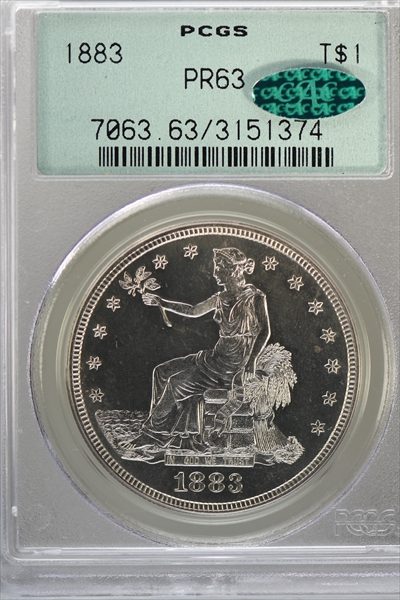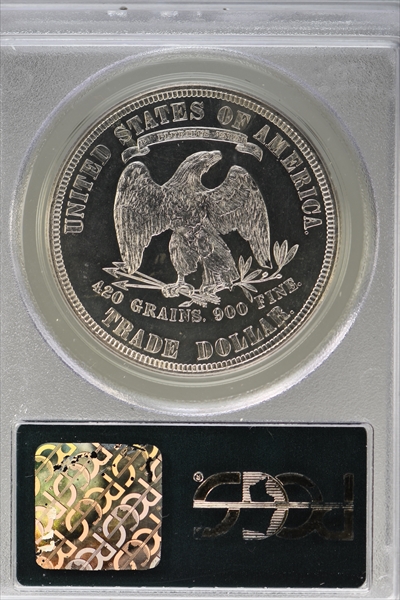1883 T$1 Trade PR63 认证号03151374, PCGS号7063
拥有者评论
CAC
专家评论
Q. David Bowers
The following narrative, with minor editing, is from my "Silver Dollars & Trade Dollars of the United States: A Complete Encyclopedia" (Wolfeboro, NH: Bowers and Merena Galleries, Inc., 1993):Coinage Context
Production limited to Proofs: In this final year of public sales of trade dollars, only Proofs were made. The figure of 979 Proof trade dollars fell short of the 1,039 Proofs made of other silver denominations.
Director recommends abolition: Horatio Burchard, who had been director of the Mint since February 1879 and who had replaced Dr. Henry R. Linderman in the post, considered the trade dollar to be a nuisance and aggravation, even though business strikes were no longer being coined. In his annual report Burchard noted in part: "Probably from five to seven millions of these coins are now held in the country, mostly in the mining and manufacturing regions of Pennsylvania and contiguous states, and in the vicinity of New York, where they have been paid to workmen and laborers, and by them paid to and received from tradesmen in those localities."
Burchard recommended that the denomination be abolished. Evidently, the small demand for Proofs did not yield enough profit to offset the costs of planchets, dies, and striking. He also urged that the government set up a redemption program to give out subsidiary silver coins in exchange for trade dollars. (The text is quoted below under Additional Information.) While abolition followed quickly, redemption had to wait until 1887.
The President dislikes trade dollars: In his annual message to Congress on December 3, 1883, President Chester A. Arthur noted that trade dollars had become a disturbing element in domestic trade, they no longer circulated actively, and "they should no longer be permitted to embarrass our currency system." He recommended they be redeemed by the Treasury and Mint "as bullion in small percentage above the current market price of silver of like fineness."
This would not have protected the miners, factory workers, and others who were receiving trade dollars in their pay envelopes at face value.
By year's end, the trade dollar had hardly any friends. As John M. Willem has written, it was truly dishonored and unwanted.
Numismatic Information
Proof mintages: During the year Proof coinage amounted to 979 pieces, some of which are believed to have been melted or spent in early 1884. Those melted or spent were probably part of the December mintage (see monthly delivery totals below).
Availability of Proofs today: 1883 Proof trade dollars are somewhat scarcer than the mintage, even allowing for some melting, would indicate. This date seems to have an unusually high number of impaired survivors; perhaps as many as 25 to 50 lightly worn ones exist.
Bruce Amspacher comments concerning this date.(In his essay, "United States Trade Dollars: 1873-1885," in The Comprehensive U.S. Silver Dollar Encyclopedia, p. 635.) "Scarce in gem condition .... Slightly sub-par in overall quality (strike, depth of mirror, eye appeal) compared to issues of 1879-82."
Varieties:
OBVERSE TYPE II, RIBBON ENDS POINT DOWN, 1876-1885
REVERSE TYPE II: NO BERRY BELOW CLAW, 1875-1885
Proofs:
1.Normal issue: Breen-5829. Somewhat scarcer than the mintage would indicate. One in the Katen Sale, June 1992, Lot 132, had Proof surface between eagle's claw and branch; arrow feathers incomplete and with Proof surface between fragments; this die was also used in 1879 (and possibly in other years). Often seen flatly struck on head and stars.
1a. Some specimens seen by the author have pronounced die doubling at the bases of some of the letters in the inscription 420 GRAINS, 900 FINE, particularly evident at FI and E of FINE. This die was also used in 1882.
Dies prepared: Obverse: Unknown; Reverse: 2' or more (including one leftover from 1882)
Proof mintage: 979; some melted, others spent.
Delivery figures by month: January: 30; February: 247; March: 298; April: 110; May: 30; Julle: 12; July: 10; August: 39; September: 25; October: 60; November: 8;, December: 110.
Characteristics of striking: Often seen flatly struck on the head and stars.
Commentary
This was a Proof-only issue made for collectors.
No business strikes were produced. It is the scarcest of the 1878-1883 Proof trade dollar issues.
Additional Information
Director Recommends End of Coinage
In the Annual Report of the, Director of the Mint, 1883, Horatio Burchard recommended that the coinage of trade dollars no longer be permitted:
"Although its coinage is now discretionary with the secretary of the Treasury and has been suspended by him, the issue of this coin in any contingency should no longer be authorized or: permitted at any of the United States 'Mints. Originally made in the Coinage Act of 1873 a legal tender, to the same extent as the other designated silver coins, a considerable number had probably, before its demonetization in 1876, gone into circulation in this country. The statistics of coinage and exports show that at the latter date the number of pieces coined exceeded the exportations by over two million dollars. Probably from five to seven millions of these coins are now held in the country, mostly in the mining and manufacturing regions of Pennsylvania and contiguous states, and in the vicinity of New York, where they have been paid to workmen and laborers, and by them paid to and received from tradesmen in those localities.
"While the United States has incurred no legal liability, yet by the Act of the government the coins were at first put into circulation and given compulsory currency, and have fallen into the hands of those who can ill afford to suffer from the depreciation, and it would seem but an Act of justice that the United States should permit these coins to be sent to the mints and exchanged for other silver coins, into which they could be profitably recoined.
"I doubt not that action of this kind would have long since been taken, but for the apprehension that a large number or exported trade dollars would be returned to this country. My own investigations and inquiries have satisfied me that the trade dollars sent to China have gone to the melting pots and become sycee silver or disappeared in the interior of that country; for, although their value as silver bullion would be only about eighty-seven cents, yet their commercial market value in New York City has, prior to the late movement to depress their price, fallen below ninety-eight Cents but once, and that for a short period, and has usually ranged for several years above ninety-nine cents, and had it been possible to secure trade dollars for import from China to this country, the profits on the operation would have brought them here long since."
Whether or not the secretary of the Treasury forbade any further mintage of Proof trade dollars, the coins of 1884 and 1885 were clandestine issues, the 1884, from allegedly unused dies (per Mint records), the 1885 without any record of dies made or destroyed. No Mint record mentions bullion sources, planchets, striking, or distribution of trade dollars of either date.
PCGS #
7063
设计师
William Barber
边缘
Reeded
直径
38.10 毫米
重量
27.20 克
铸币数量
979
金属成分
90% Silver, 10% Copper
更高评级数量
221
评级较低的钱币数量
179
地区
The United States of America
价格指南
PCGS 数量报告
拍卖 - PCGS 评级的
拍卖 - NGC 评级的
稀有性和存量估计 了解更多
| 所有评级 | 900 |
| 60或以上 | 840 |
| 65或以上 | 175 |
| 所有评级 | R-5.2 |
| 60或以上 | R-5.3 |
| 65或以上 | R-7.2 |
| 所有评级 | 10 / 13 |
| 60或以上 | 10 / 13 |
| 65或以上 | 8 / 13 TIE |
| 所有评级 | 10 / 13 |
| 60或以上 | 10 / 13 |
| 65或以上 | 8 / 13 TIE |























